



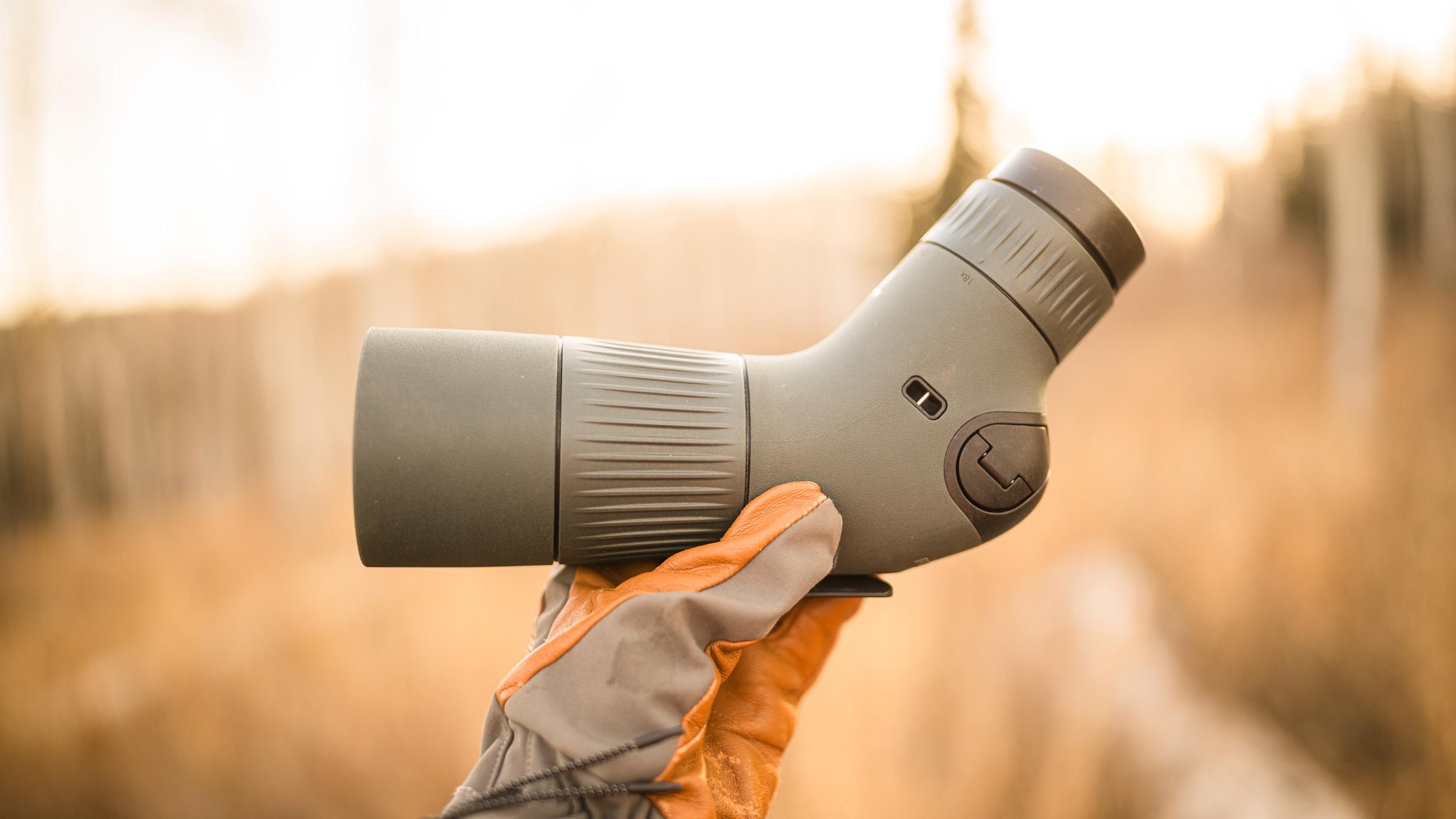
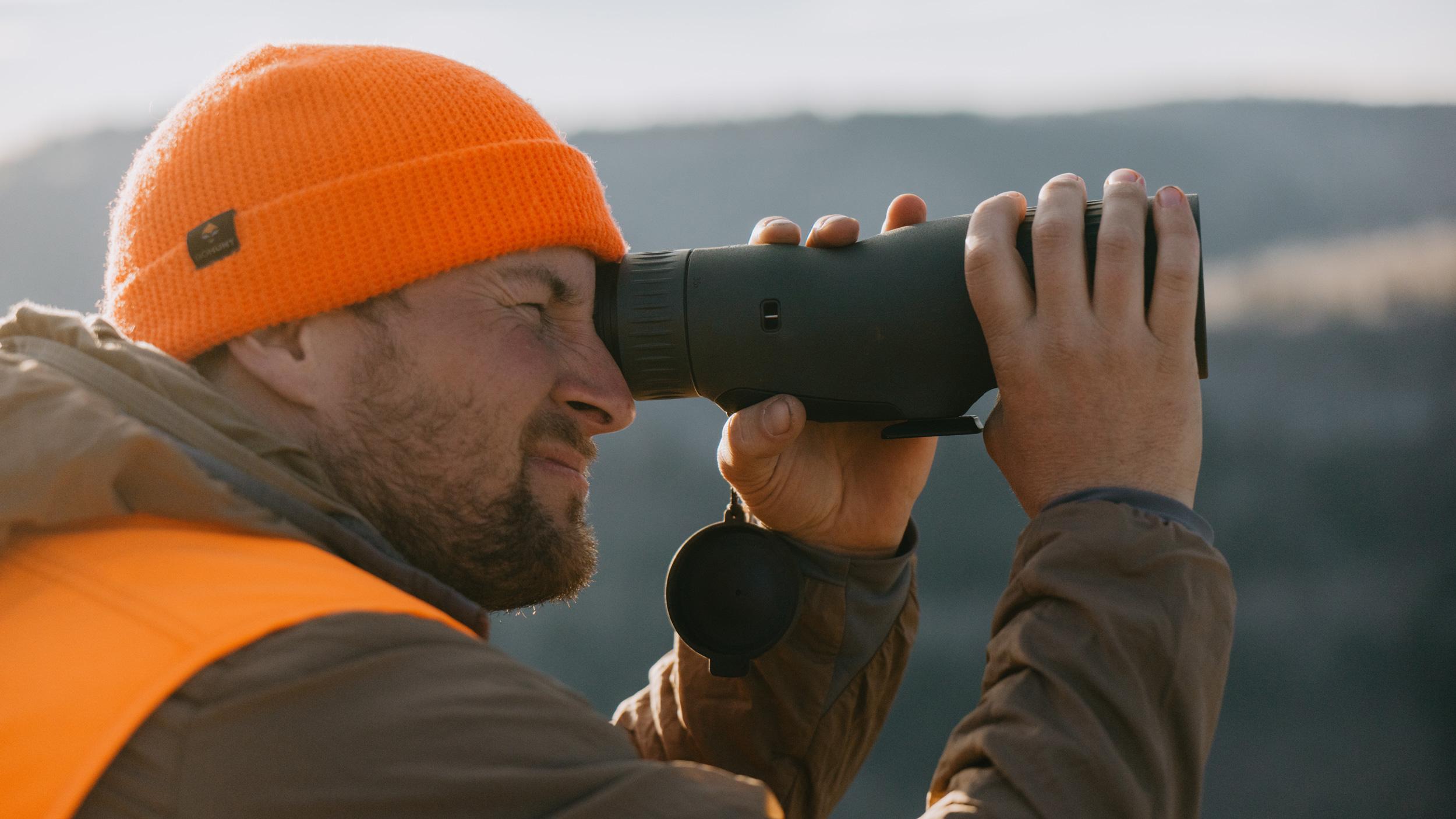
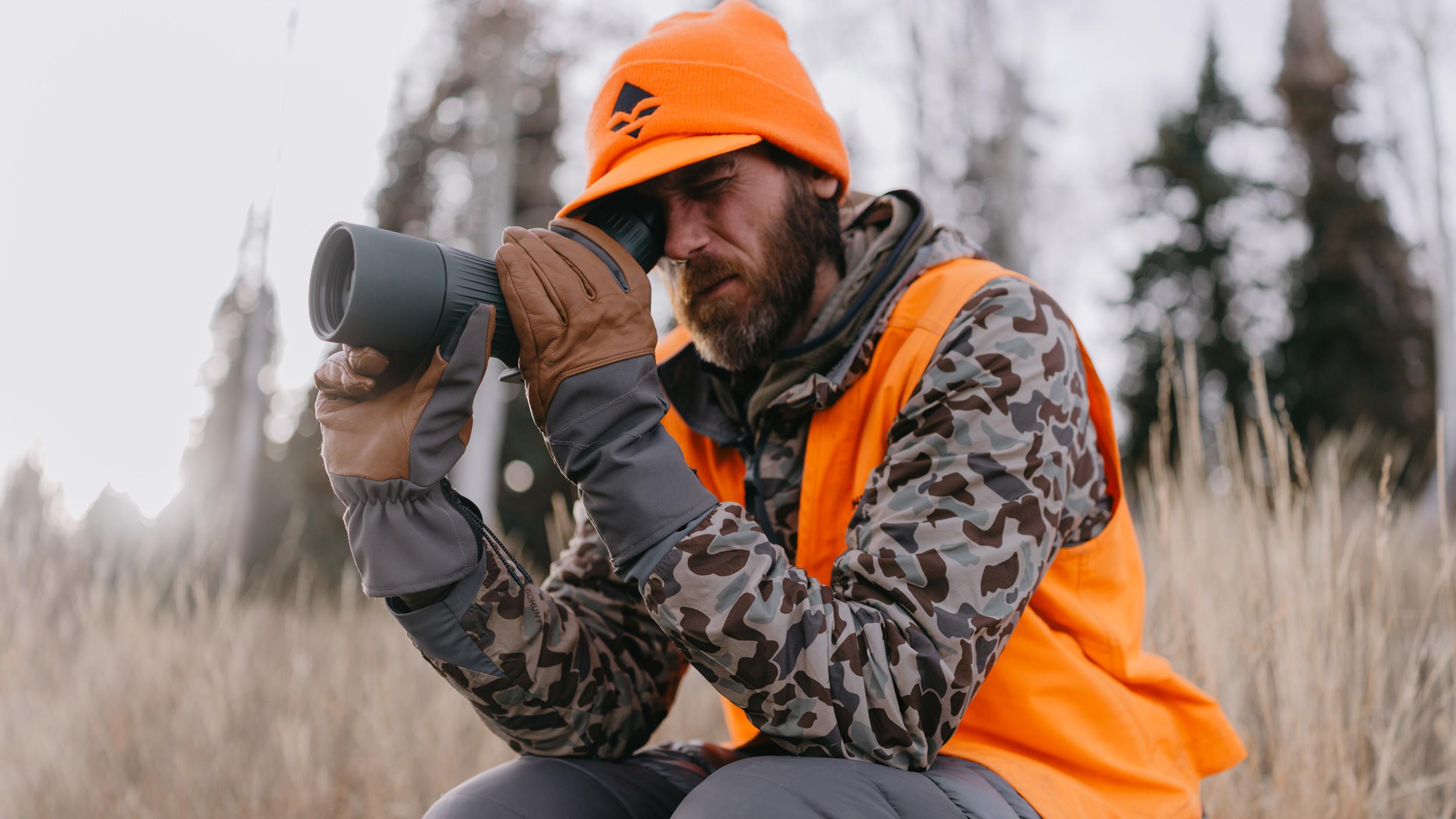
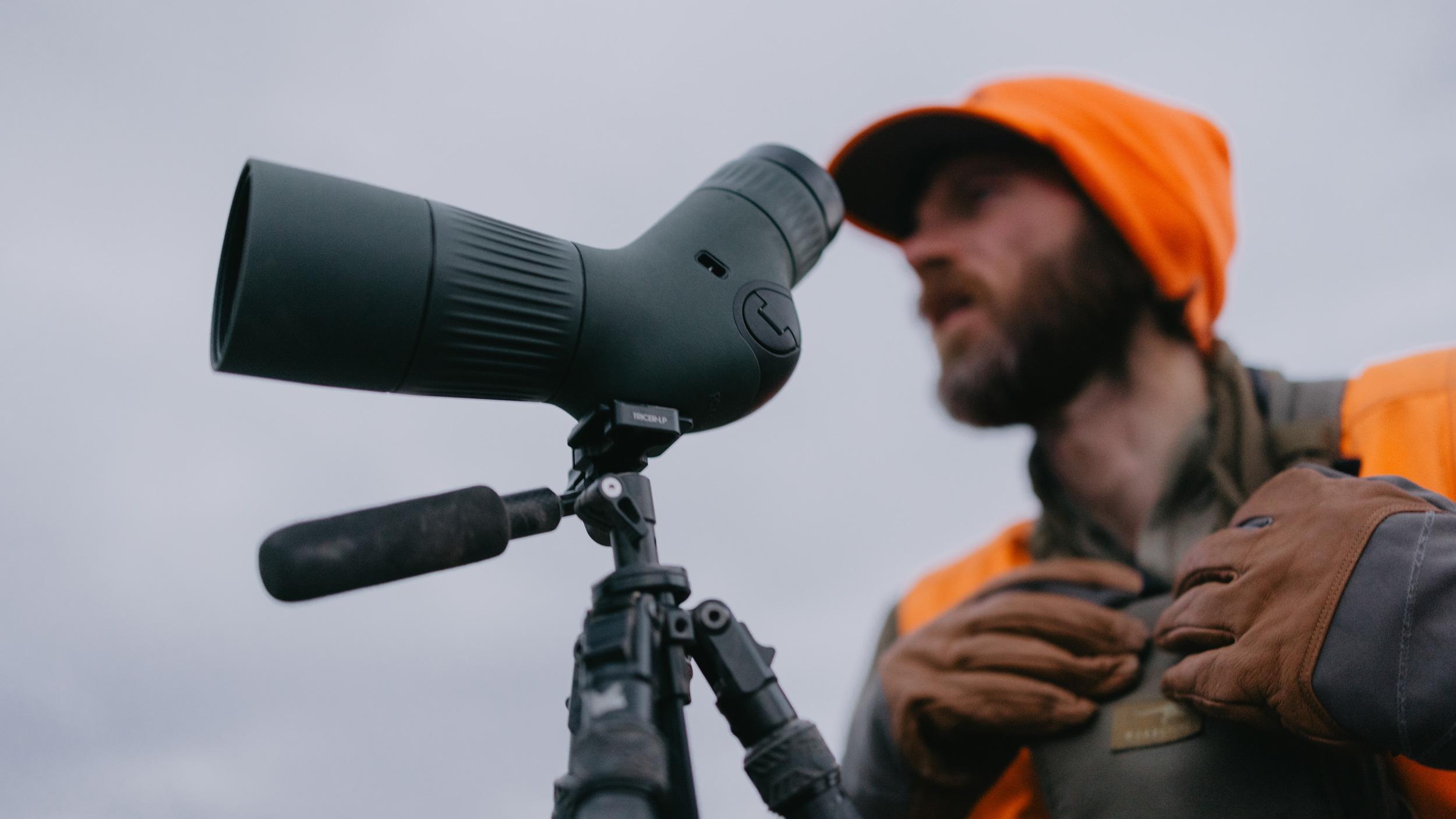
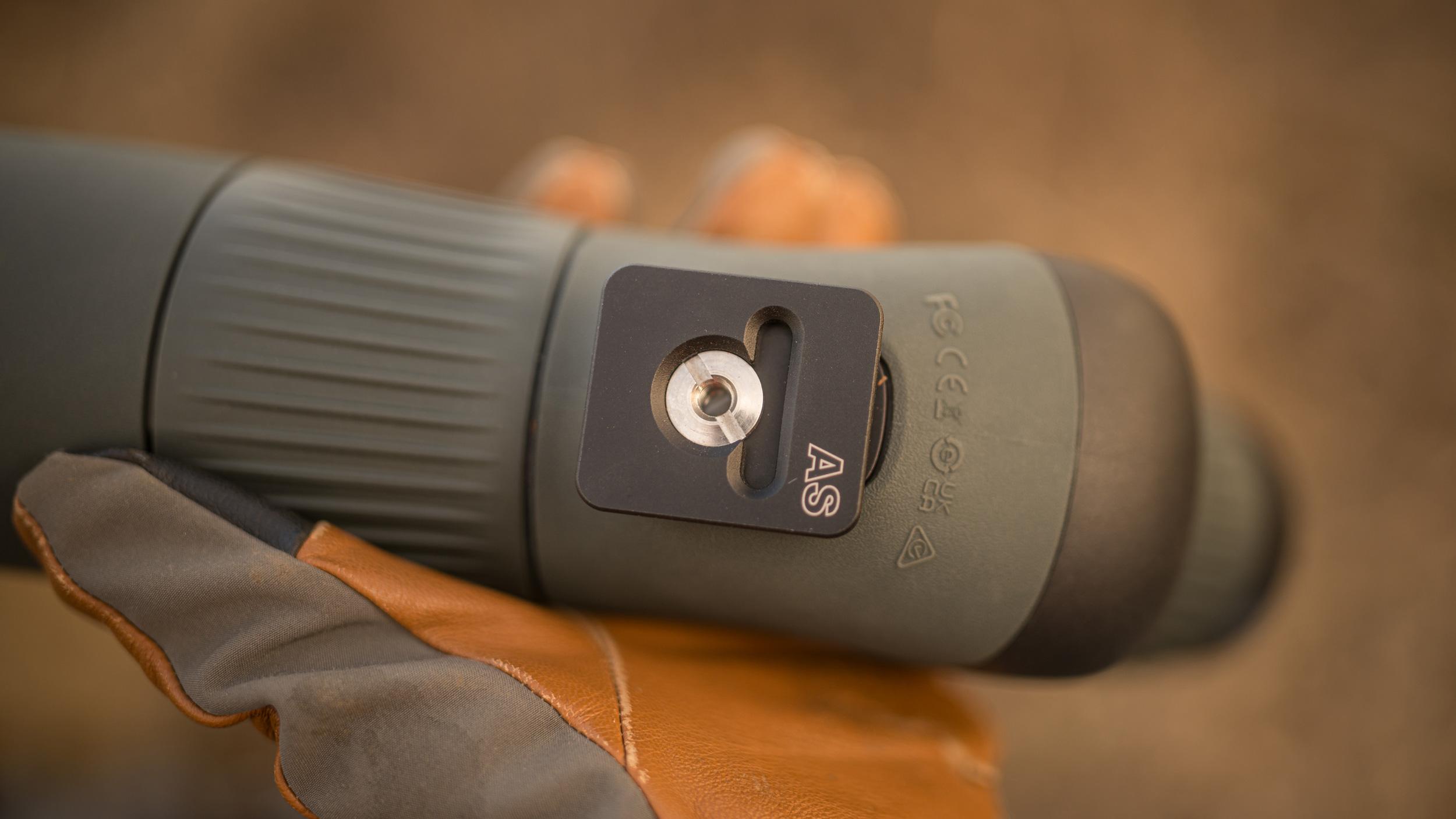
Tripod adapter plate on the Swarovski Balance image stabilized spotting scope.
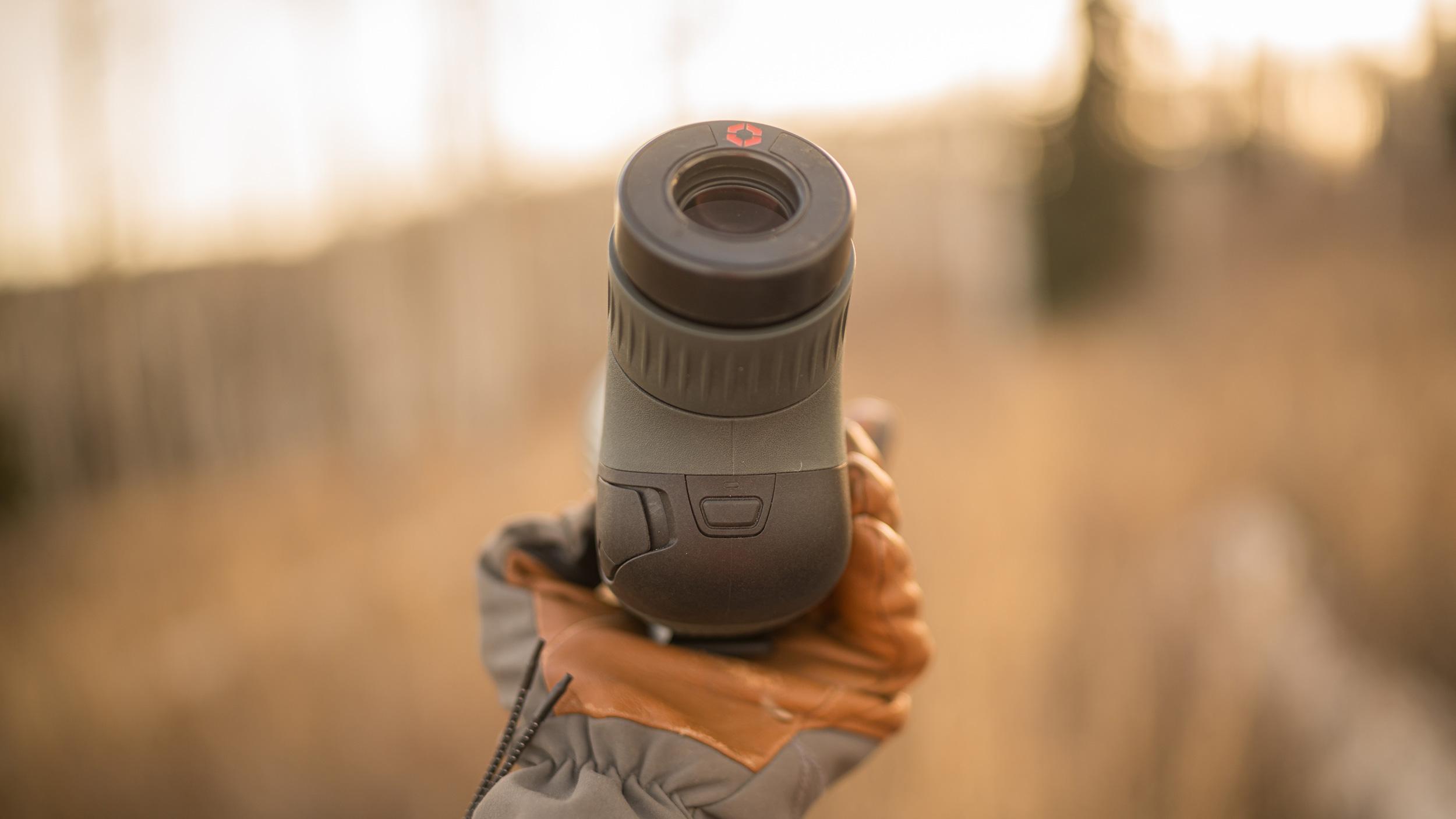
| Magnification |
|---|---|
AT Balance 18-45x65 | 18-45x |
ST Balance 14-35x50 | 14-35x |
| Objective lens diameter |
AT Balance 18-45x65 | 65 |
ST Balance 14-35x50 | 50 |
| Exit pupil diameter (mm) |
AT Balance 18-45x65 | 3.4-1.4 |
ST Balance 14-35x50 | 3.4-1.4 |
| Exit pupil distance (mm) |
AT Balance 18-45x65 | 20 |
ST Balance 14-35x50 | 20 |
| Field of view (1,000 yards) |
AT Balance 18-45x65 | 165ft - 90ft |
ST Balance 14-35x50 | 210ft - 117ft |
| Field of view (degrees) |
AT Balance 18-45x65 | 3.16 - 1.74 |
ST Balance 14-35x50 | 4 - 2.2 |
| Field of view, apparent (degrees) |
AT Balance 18-45x65 | 57-71 |
ST Balance 14-35x50 | 57-71 |
| Shortest focusing distance (ft) |
AT Balance 18-45x65 | 3.4/11.2 |
ST Balance 14-35x50 | 3.4/11.2 |
| Light transmission (%) |
AT Balance 18-45x65 | 88% |
ST Balance 14-35x50 | 88% |
| Dimensions (in) |
AT Balance 18-45x65 | 10.6” x 3.3” x 5.8” |
ST Balance 14-35x50 | 10.6” x 3.6” x 3.1” |
| Weight (oz) |
AT Balance 18-45x65 | 51.9oz |
ST Balance 14-35x50 | 45.9oz |
| AT Balance 18-45x65 | ST Balance 14-35x50 |
|---|---|---|
Magnification | 18-45x | 14-35x |
Objective lens diameter | 65 | 50 |
Exit pupil diameter (mm) | 3.4-1.4 | 3.4-1.4 |
Exit pupil distance (mm) | 20 | 20 |
Field of view (1,000 yards) | 165ft - 90ft | 210ft - 117ft |
Field of view (degrees) | 3.16 - 1.74 | 4 - 2.2 |
Field of view, apparent (degrees) | 57-71 | 57-71 |
Shortest focusing distance (ft) | 3.4/11.2 | 3.4/11.2 |
Light transmission (%) | 88% | 88% |
Dimensions (in) | 10.6” x 3.3” x 5.8” | 10.6” x 3.6” x 3.1” |
Weight (oz) | 51.9oz | 45.9oz |
Spotting Scope | Swarovski AT Balance |
|---|---|
Weight | 3 pounds 3.9 oz |
Power/Objective | 18-45x65 |
Spotting Scope | Swarovski ST Balance |
Weight | 2 pounds 13.9 oz |
Power/Objective | 14-35x50 |
Spotting Scope | Swarovski ATC |
Weight | 2 pounds 2.2 oz |
Power/Objective | 17-40x56 |
Spotting Scope | Swarovski STC |
Weight | 2 pounds 2.6 oz |
Power/Objective | 17-40x56 |
Spotting Scope | Swarovski ATX w/ 65mm objective |
Weight | 3 pounds 7.9 oz |
Power/Objective | 25-60x65 |
Spotting Scope | Swarovski STX w/ 65mm objective |
Weight | 3 pounds 7.9 oz |
Power/Objective | 25-60x65 |
Spotting Scope | Swarovski ATS - 65 HD |
Weight | 2 pounds 15.3 oz |
Power/Objective | 20-60x65 |
Spotting Scope | Swarovski STS - 65 HD |
Weight | 2 pounds 15.3 oz |
Power/Objective | 20-60x65 |
Spotting Scope | Swarovski ATS - 65 HD 25-50x |
Weight | 3 pounds 0.5 oz |
Power/Objective | 25-50x65 |
Spotting Scope | Swarovski STS - 65 HD 25-50x |
Weight | 3 pounds 0.5 oz |
Power/Objective | 25-50x65 |
Spotting Scope | Weight | Power/Objective |
|---|---|---|
Swarovski AT Balance | 3 pounds 3.9 oz | 18-45x65 |
Swarovski ST Balance | 2 pounds 13.9 oz | 14-35x50 |
Swarovski ATC | 2 pounds 2.2 oz | 17-40x56 |
Swarovski STC | 2 pounds 2.6 oz | 17-40x56 |
Swarovski ATX w/ 65mm objective | 3 pounds 7.9 oz | 25-60x65 |
Swarovski STX w/ 65mm objective | 3 pounds 7.9 oz | 25-60x65 |
Swarovski ATS - 65 HD | 2 pounds 15.3 oz | 20-60x65 |
Swarovski STS - 65 HD | 2 pounds 15.3 oz | 20-60x65 |
Swarovski ATS - 65 HD 25-50x | 3 pounds 0.5 oz | 25-50x65 |
Swarovski STS - 65 HD 25-50x | 3 pounds 0.5 oz | 25-50x65 |
If you’ve ever said, “I wonder when Swarovski will enter the stabilized optic game,” well, that time is now!
Enter the Swarovski AT Balance (angled version) in 18-45x65 and the Swarovski ST Balance (straight version) in 14-35x50. Two different models to accommodate people who prefer straight or angled. Both have image stabilization. Note that the two models have different zoom ranges and objective sizes.
Lane Colyer and I got a chance to test these spotting scopes out on a recent elk hunt this fall, and they lived up to the hype of a phenomenal new addition to Swarovski.
Being able to grab a spotting scope and check out an animal quickly has its benefits. With this new spotting scope, you no longer need to mess around with trying to set up a tripod to check out an animal at higher magnification with a spotting scope, because you now have a tripod built into the spotting scope (image stabilization).
Companies are continuing to innovate, and this new image-stabilized spotting scope from Swarovski is a great step in the right direction, giving hunters more options and, at the same time, helping solve problems we all face in the field.
The beauty of this system, of course, is image stabilization. You can use this spotting scope handheld, WITHOUT a tripod. And you can easily digiscope with the stabilization turned on while handholding it.
According to Swarovski, this system uses “the precise alignment of sensors, motors, and optical as well as mechanical components ensures an extremely natural and comfortable viewing experience – even in motion. More than one thousand measurements per second continuously adjust the lens position, compensating instantly for even the slightest hand movements. The result is image stabilization with exceptionally low latency, delivering a steady, clear view without distracting after-effects. SWAROBALANCE defines new standards in observation quality.”
You can use the AT/ST Balance while standing without a tripod; you can lean it against something, or use your arms to give the system extra support. The options are endless.
There are definite benefits to using an image-stabilized spotting scope on a tripod.
So if you do want to use the spotting scope on a tripod, you can use it like a normal spotting scope without the image stabilization turned on if you attach the included foot plate. If you’re glassing in the wind off a tripod, simply switch the stabilization on, and instantly you have a vibration-free image to remove some of the wind and shake.
In hunter terms, this system flat-out works! You have a small button on the rear of the optic that you can press to engage the stabilization mode. And from there, it's pretty much out of my hands in terms of how they designed their stabilization, but below is some information from Swarovski.
"The AT/ST Balance spotting scopes have a moving lens that is adjusted by an electric motor (voice coil motor) to offset movements. These motors work particularly quickly, very precisely, and with low friction – the pushing and pulling movements are smooth and continuous. They are also used in applications such as camera autofocus systems. The integrated gyroscope sensor measures the current movement of the spotting scope. Based on this, a calculation is made to determine which lens movement is necessary to compensate for the motion to result in a stable image. With the stabilization concept of the AT/ST Balance also in movement there is no perceptible “floating” or “after-image”, which is key to the unique natural sense of vision. Automatic locking of the moving lens in the event of a fall or a sudden interruption in the power supply protects the lens while also ensuring the best optical quality by keeping the lens in the central position."
The stabilization portion is achieved with an RB-S rechargeable battery. With stabilization, the battery life is approximately 12 hours in continuous use, and this value can vary depending on the temperature at which you use the optic.
One great feature I really appreciated is the AT/ST Balance switches to an automatic time-out mode after five minutes in an idle state. Then, if you tilt the device slightly, it reactivates the stabilization again. This helps ensure you don’t drain your battery if you set the optic down.
That battery can be charged with a battery charger, and you could plug it into a battery pack in the field or use a wall outlet if you’re staying at a hotel.
As mentioned earlier, in terms of latency, you get a very smooth and responsive glassing experience with the image stabilization turned on. No floating, and no trying to catch up when moving around or panning.
Cody Nelson has been using the new Swarovski AT/ST Balance as well, and I asked him for his thoughts:
"Swarovski is jumping into the image stabilization game with both feet! The AT/ST Balance is making hand-holding spotters, digiscoping, and long-range spotting with precision more possible! Swaro glass with image stabilization isn’t changing the game, it is changing the field it’s played on!”
“Focus under steadiness with the Swarovski AT/ST Balance. When looking at long distances, the stabilization provides extra crisp focus, letting you see clearly without distortion. The finer the focus, the better the image!"
Let’s talk about glass quality really quickly. The AT/ST Balance doesn't skimp on glass quality, and in typical Swarovski fashion, you have crystal clear optics, with the edge-to-edge clarity you expect.
Warranty
SWAROVSKI OPTIK offers a lifetime warranty against defects in materials or workmanship on the optical system of our products for products purchased by US and Canadian residents from an authorized SWAROVSKI OPTIK NORTH AMERICAN dealer. SWAROVSKI OPTIK warrants all other parts of the instrument for 10 years, and 5 years for electronic parts. The rechargeable battery is covered by a warranty period of 1 year; battery charger is a covered warranty of 3 years.
Accessories included when you buy this spotting scope:
Note: If you want to digiscope with this system, the AT/ST Balance uses the same Ollin Snapshot Spotter System as the ATX/STX/ATC/STC, so for our recent hunt, I was able to pull the Snapshot off my ATX eyepiece for digiscoping.
I get this question all the time. Is an image-stabilized optic, or in this case, an image-stabilized spotting scope, worth it?
If you're the type of hunter who spends long days in the mountains picking apart basins, analyzing far off ridgelines, and sizing up animals at extreme distances, you're bound to face a situation when having the Swarovski AT/ST Balance stabilized spotting scope will shine.
The AT/ST Balance is a purpose-built optic, and it will shine in the hands of people who want more from their glass when hunting, and the extra features are worth it to them.
Below are what I consider to be the benefits of an image-stabilized spotting scope.
In my opinion, it is worth noting that this spotting scope is a little on the heavier side compared to a normal spotting scope. So, you will have to decide whether you value weight or stabilization features more, and what stabilization will give you in the field.
Below, I compare the new stabilized AT/ST Balance with other similar spotting scopes from Swarovski.
If you have questions about Swarovski optics, gear needed when glassing, or further explanation, please feel free to comment or reach out to our Optics Manager, Cody Nelson, at optics@gohunt.com, or you can give him a call at 702-847-8747. Cody is always willing to lend a hand when it comes to everything optics and glassing.
I've obviously used both the SIG SAUER OSCAR6 HDX Pro image-stabilized spotting scope and now the Swarovski AT Balance, so stay tuned for a more in-depth look at both optics.
RB-S rechargeable battery
Battery charger including USB-C cable
Carrying strap
Objective lens cover and eyepiece cover
Tripod adapter plate
Windy conditions: If you frequently battle winds where you hunt, image stabilization technology drastically improves glassing, where traditional spotting scopes struggle in the wind.
Fast glassing situations: When you can’t always set up a full tripod system, a stabilized spotting scope lets you confidently glass handheld or from improvised positions, like off your backpack or against a tree.
Smooth video when digiscoping: Everyone loves digiscoping animals, and I feel everyone can benefit from better video with stabilized footage.
Truck glassing: If you’re glassing from the truck on a cold day and it’s blowing snow, and you have the truck running, you can now mount an AT/ST Balance image-stabilized spotting scope on a window mount, and you can glass as if you were out of the truck on a calm day on a tripod.
Field-judging: If you're making stalking decisions based on antlers or horn length, a stabilized spotting scope can give you more reliable detail without the frustrating image shake.
Go lightweight without a tripod: Technically, you could now hunt without a tripod and use the stabilization built into the AT/ST Balance image-stabilized spotting scope to get a clear and steady picture when trying to glass something really far away.